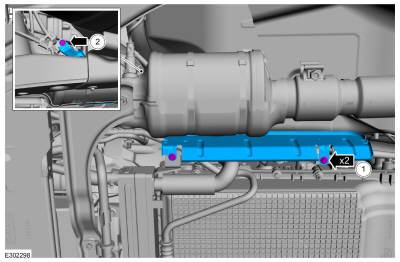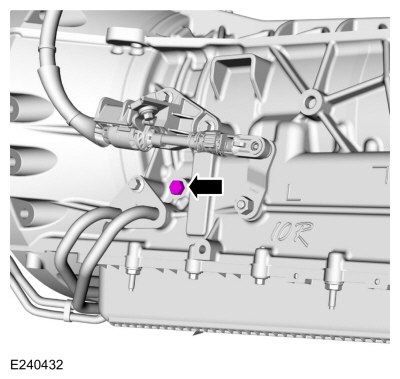Lincoln Navigator: Automatic Transmission - 10-Speed Automatic Transmission – 10R80 / Special Testing Procedures. Diagnosis and Testing
Line Pressure Test
This test verifies the line pressure is within specification.
-
If available, refer to the Transmission Line Pressure Test general procedure to access the line pressure tap.
-
If equipped, remove the heat shield.
-
Remove the 2 bolts. Torque: 10 Nm (88 lb-in)
-
Remove the push pin and the heat shield.
-
Remove the 2 bolts. Torque: 10 Nm (88 lb-in)

-
Connect the transmission fluid pressure gauge (307-004) to the line pressure tap using an M10 X 1.00 fitting.
NOTE: The line pressure tap is an M10 X 1.00 thread. Do not use a National Pipe Thread (NPT) fitting when installing a pressure gauge. If a NPT fitting is used, damage to the transmission case will occur.
NOTE: 10R80 shown, 10R60 similar

-
Start the engine and check the line pressure.
-
Using a diagnostic scan tool, monitor and compare the PID LINEDSD# to
actual measured pressure. Actual measured pressure should be within 10
PSI (69 kPa) of PID
LINEDSD#. Raise engine RPM to 2000 RPM and verify LPC operation by
monitoring line pressure while commanding LINEDSD# up and down.
-
If the line pressure is not within specification, see the Line Pressure Diagnosis Chart for possible sources.
-
When the pressure tests are complete, install the line pressure tap plug.
-
Tighten to 11 Nm (97 lb-in).
-
Tighten to 11 Nm (97 lb-in).
Line Pressure Diagnosis Chart
| Test Results | Possible Source |
| HIGH at IDLE |
|
| LOW at IDLE OR Does not change when commanding LINEDSD# up and down |
|
A no-drive condition can exist even with correct transmission fluid pressure because of inoperative clutches. Refer to the Clutch Application Chart to determine which clutch is applied in each gear range. A clutch concern can be further diagnosed by performing the air pressure test.
Stall Speed Test
NOTE: Carry out the Line Pressure Test prior to the Stall Speed Test. If line pressure is low, do not carry out the stall test or additional transmission damage will occur. Do not maintain Wide Open Throttle (WOT) in any gear range for more than 5 seconds.
NOTE: If the engine speed exceeds maximum specified rpm, release the accelerator pedal immediately.
NOTE: Only perform the stall speed test with the engine and transmission at normal operating temperatures.
To prevent damage to transmission and driveline components, the PCM will truncate engine torque output when a stall condition exists. Because of this torque truncation, the stall test cannot be used as a diagnostic test for determining the health of the transmission clutches.
The PCM monitors clutch performance and will set one or more DTC s when an undesired slip is detected.
The torque converter stator one-way clutch should hold at idle and during acceleration. A failed one-way clutch can be identified if all of the following conditions/symptoms exist:
- Transmission fluid is clean and free of excessive contamination
- Normal/expected vehicle performance at cruising speed
- Poor engine idle quality. The engine may even stall
- Very poor acceleration/Lack of power
- Very low stall RPM: <1500 RPM. Perform test procedure below:
-
Apply the parking brake.
-
Connect the scan tool. Navigate to Datalogger: PCM
-
Monitor the PID s: APP (%), RPM, LOAD (%) and GEAR_CMD
-
Start the engine.
-
Place the transmission in reverse.
-
Start datalogger recording.
-
With the brake pedal firmly applied, press the accelerator pedal to
100% for 2-3 seconds until engine RPM stabilizes. Release the
accelerator pedal.
-
Place the transmission in neutral.
-
Press the accelerator pedal to maintain 1500 RPM for 10 seconds to
allow the torque converter to cool. Release the accelerator pedal.
-
Place the transmission in drive.
-
With the brake pedal firmly applied, press the accelerator pedal to
100% for 2-3 seconds until engine RPM stabilizes. Release the
accelerator pedal.
-
Place the transmission in neutral.
-
Press the accelerator pedal to maintain 1500 RPM for 10 seconds to
allow the torque converter to cool. Release the accelerator pedal.
-
Turn the engine off.
-
Review the recording. A properly functioning stator one-way clutch should fall within the following parameters:
-
APP = 100%
-
RPM > 1500
-
LOAD < 100%
-
GEAR_CMD = Reverse or 1st Gear commanded
-
APP = 100%
Air Pressure Test

10R60/10R80 Air Ports
| Item | Description |
| 1 | A clutch |
| 2 | B clutch |
| 3 | C clutch |
| 4 | D clutch |
| 5 | E clutch |
| 6 | F clutch |
| 7 | TCC apply |
| 8 | TCC release |
| 9 | Lube |
| 10 | To cooler |
| 11 | From cooler |
| 12 | Line pressure tap |
-
Using a high volume rubber tipped blow gun, apply air pressure to the suspect clutch port for 2-3 seconds.
-
While applying air pressure, a dull thud on clutches A and B would indicate the clutch piston is applied.
-
While applying air pressure, a hissing noise may indicate a leak in the hydraulic passages.
-
While applying air pressure, cross leakage in the hydraulic
circuit between the C, D, E and F rotating clutch seals is expected.
 Diagnosis By Symptom. Diagnosis and Testing
Diagnosis By Symptom. Diagnosis and Testing
Global Customer Symptom Code (GCSC) Chart
Diagnostics in this manual assume a certain skill level and knowledge of Ford-specific diagnostic practices REFER to: Diagnostic Methods (100-00 General Information, Description and Operation)...
 A Clutch. Diagnosis and Testing
A Clutch. Diagnosis and Testing
A Clutch Assembly
A Clutch
For A clutch operation, REFER to: A Clutch (307-01 Automatic Transmission - 10-Speed Automatic Transmission – 10R80, Description and Operation)...
Other information:
Lincoln Navigator 2018-2025 Workshop Manual: Oil Leak Inspection. General Procedures
NOTE: If an overnight drive is done, the fan air or road air blast can cause erroneous readings. NOTE: When diagnosing engine oil leaks, the source and location of the leak must be positively identified prior to repair. Prior to carrying out this procedure, clean the cylinder block, cylinder heads, valve covers, oil pan and flywheel/flexplate with a suitable solvent t..
Lincoln Navigator 2018-2025 Workshop Manual: Specifications
LUBRICANTS, FLUIDS AND CAPACITIES NOTE: Per the warranty and policy manual the Ford Engineering-approved refrigerant (see table for service part number) must be used for air conditioning repairs ITEM CAPACITIES US, Canada, PAG oil used with R1234YF: Material: Motorcraft® R-1234yf Refrigerant PAG Oil / YN-35 ..
Categories
- Manuals Home
- 4th Gen Lincoln Navigator Service Manual (2018 - 2025)
- Remote Function Actuator (RFA) Module. Removal and Installation
- All Terrain Control Module (ATCM). Removal and Installation
- Satellite Radio Antenna. Removal and Installation
- Front Bumper Cover. Removal and Installation
- Brake Service Mode Activation and Deactivation. General Procedures
Rear Stabilizer Bar Link. Removal and Installation
Removal
NOTE: Removal steps in this procedure may contain installation details.
With the vehicle in NEUTRAL, position it on a hoist.Refer to: Jacking and Lifting (100-02 Jacking and Lifting, Description and Operation).
NOTE: Use the hex-holding feature to prevent the stud from turning while removing the nut.
Remove and discard the 2 rear stabilizer bar link nuts and remove the rear stabilizer bar link.Torque: 46 lb.ft (63 Nm)

